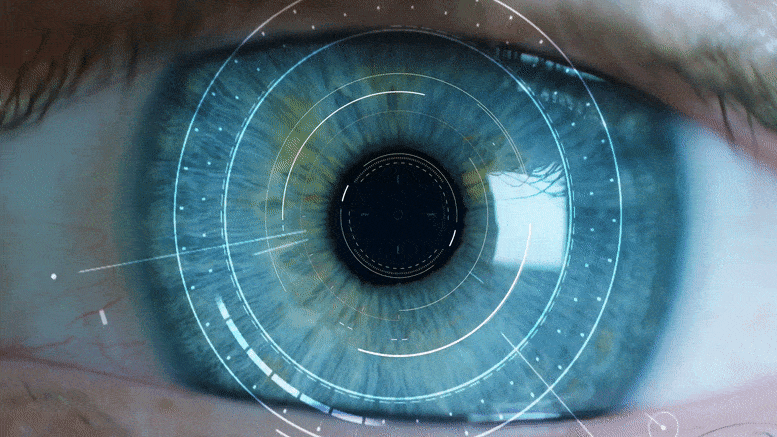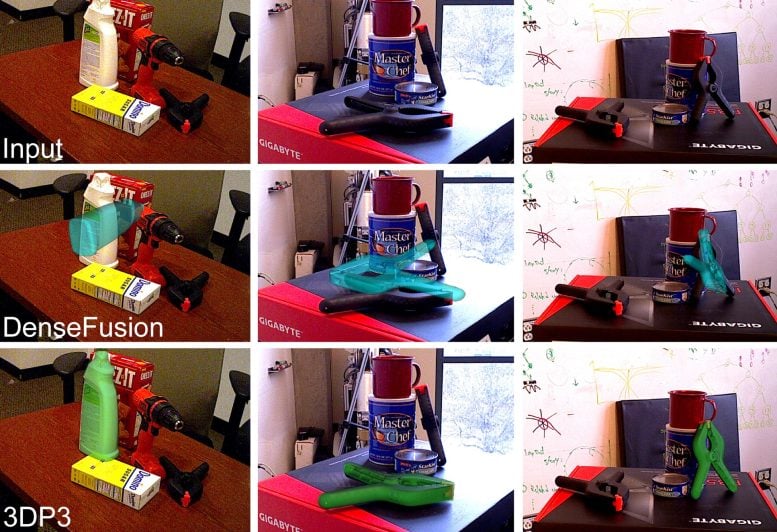
A new “common-sense” approach to computer vision enables artificial intelligence that interprets scenes more accurately than other systems do.
Computer vision systems sometimes make inferences about a scene that fly in the face of common sense. For example, if a robot were processing a scene of a dinner table, it might completely ignore a bowl that is visible to any human observer, estimate that a plate is floating above the table, or misperceive a fork to be penetrating a bowl rather than leaning against it.
Move that computer vision system to a self-driving car and the stakes become much higher — for example, such systems have failed to detect emergency vehicles and pedestrians crossing the street.
To overcome these errors, 
This image shows how 3DP3 (bottom row) infers more accurate pose estimates of objects from input images (top row) than deep learning systems (middle row). Credit: Courtesy of the researchers
This common-sense safeguard allows the system to detect and correct many errors that plague the “deep-learning” approaches that have also been used for computer vision. Probabilistic programming also makes it possible to infer probable contact relationships between objects in the scene, and use common-sense reasoning about these contacts to infer more accurate positions for objects.
“If you don’t know about the contact relationships, then you could say that an object is floating above the table — that would be a valid explanation. As humans, it is obvious to us that this is physically unrealistic and the object resting on top of the table is a more likely pose of the object. Because our reasoning system is aware of this sort of knowledge, it can infer more accurate poses. That is a key insight of this work,” says lead author Nishad Gothoskar, an electrical engineering and computer science (EECS) PhD student with the Probabilistic Computing Project.
In addition to improving the safety of self-driving cars, this work could enhance the performance of computer perception systems that must interpret complicated arrangements of objects, like a robot tasked with cleaning a cluttered kitchen.
Gothoskar’s co-authors include recent EECS PhD graduate Marco Cusumano-Towner; research engineer Ben Zinberg; visiting student Matin Ghavamizadeh; Falk Pollok, a software engineer in the MIT-IBM Watson AI Lab; recent EECS master’s graduate Austin Garrett; Dan Gutfreund, a principal investigator in the MIT-IBM Watson AI Lab; Joshua B. Tenenbaum, the Paul E. Newton Career Development Professor of Cognitive Science and Computation in the Department of Brain and Cognitive Sciences (BCS) and a member of the Computer Science and Artificial Intelligence Laboratory; and senior author Vikash K. Mansinghka, principal research scientist and leader of the Probabilistic Computing Project in BCS. The research is being presented at the Conference on Neural Information Processing Systems in December.
A blast from the past
To develop the system, called “3D Scene Perception via Probabilistic Programming (3DP3),” the researchers drew on a concept from the early days of AI research, which is that computer vision can be thought of as the “inverse” of computer graphics.
Computer graphics focuses on generating images based on the representation of a scene; computer vision can be seen as the inverse of this process. Gothoskar and his collaborators made this technique more learnable and scalable by incorporating it into a framework built using probabilistic programming.
“Probabilistic programming allows us to write down our knowledge about some aspects of the world in a way a computer can interpret, but at the same time, it allows us to express what we don’t know, the uncertainty. So, the system is able to automatically learn from data and also automatically detect when the rules don’t hold,” Cusumano-Towner explains.
In this case, the model is encoded with prior knowledge about 3D scenes. For instance, 3DP3 “knows” that scenes are composed of different objects, and that these objects often lay flat on top of each other — but they may not always be in such simple relationships. This enables the model to reason about a scene with more common sense.
Learning shapes and scenes
To analyze an image of a scene, 3DP3 first learns about the objects in that scene. After being shown only five images of an object, each taken from a different angle, 3DP3 learns the object’s shape and estimates the volume it would occupy in space.
“If I show you an object from five different perspectives, you can build a pretty good representation of that object. You’d understand its color, its shape, and you’d be able to recognize that object in many different scenes,” Gothoskar says.
Mansinghka adds, “This is way less data than deep-learning approaches. For example, the Dense Fusion neural object detection system requires thousands of training examples for each object type. In contrast, 3DP3 only requires a few images per object, and reports uncertainty about the parts of each objects’ shape that it doesn’t know.”
The 3DP3 system generates a graph to represent the scene, where each object is a node and the lines that connect the nodes indicate which objects are in contact with one another. This enables 3DP3 to produce a more accurate estimation of how the objects are arranged. (Deep-learning approaches rely on depth images to estimate object poses, but these methods don’t produce a graph structure of contact relationships, so their estimations are less accurate.)
Outperforming baseline models
The researchers compared 3DP3 with several deep-learning systems, all tasked with estimating the poses of 3D objects in a scene.
In nearly all instances, 3DP3 generated more accurate poses than other models and performed far better when some objects were partially obstructing others. And 3DP3 only needed to see five images of each object, while each of the baseline models it outperformed needed thousands of images for training.
When used in conjunction with another model, 3DP3 was able to improve its